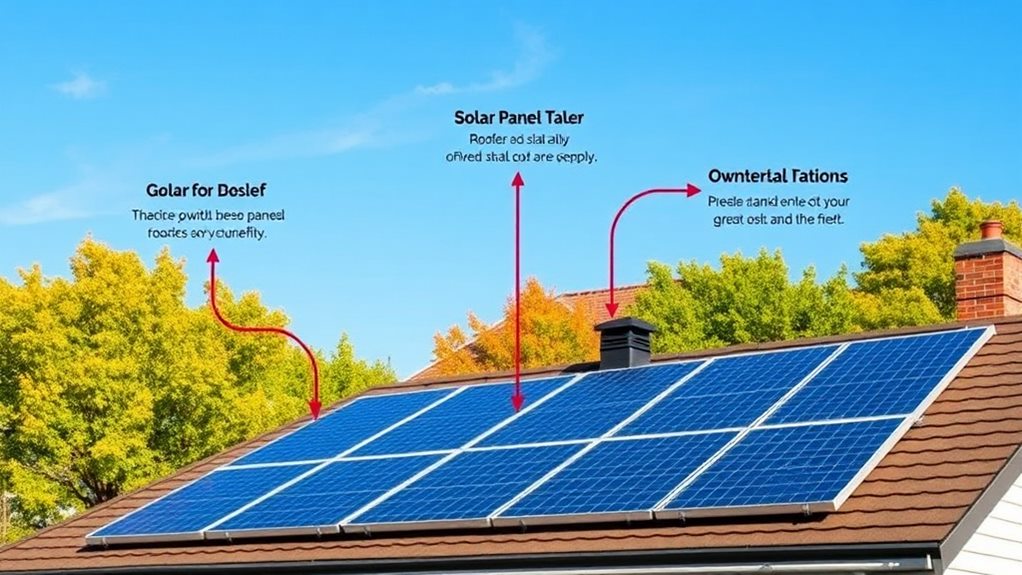To qualify for federal solar rebates, start by ensuring you own the solar system, as leased systems aren't eligible. Keep meticulous records of all installation costs, including related expenses like sales tax and wiring. Verify that your installation occurs between January 1, 2017, and December 31, 2034. Consulting a tax professional can clarify eligibility and assist with IRS Form 5695, helping you avoid errors. Finally, stay informed about future changes to the federal solar tax credit and local incentives, as these can impact your benefits considerably. There are essential details to take into account that could enhance your eligibility further.
Understand Ownership Requirements

Understanding ownership requirements is vital for anyone looking to take advantage of the Federal Solar Tax Credit. To qualify, you must own the solar energy system outright; this means that leased systems or power purchase agreements (PPAs) don't meet eligibility requirements.
Ownership entails that you're responsible for the purchase and installation of the solar equipment, which must be either new or used for the first time. Additionally, it's significant to be aware of various solar energy incentives available that can further assist with the financial aspect of installation.
Moreover, the installation must occur on your primary or secondary residence in the U.S. You need to reside in that property for part of the year to be eligible. It's important to recognize that you must have tax liability in the year you install the solar system, as the credit can't be applied to leased systems or those without ownership.
To accurately claim the Federal Solar Tax Credit on your federal tax return, you must maintain thorough documentation proving ownership of the solar system. This includes keeping receipts and installation contracts.
Document Your Installation Costs
Documenting your installation costs is essential for maximizing your benefits from the Federal Solar Tax Credit. To claim this credit effectively, keep detailed records of all installation-related expenses. This includes receipts for solar panels, inverters, labor, permitting, and inspection fees.
Don't forget to document your sales tax on eligible solar equipment, as this can also be included in your tax credit claim. By investing in solar energy, you can potentially eliminate utility bills entirely and redirect those savings to other expenses or savings, making meticulous documentation even more significant for your financial planning.
Only original installation costs qualify for the federal solar tax credit, so previous expenses related to used equipment or reinstallation won't count. Be sure to document any additional costs associated with your solar installation, like wiring and battery storage, provided they meet the minimum capacity requirements.
Utilizing IRS Form 5695 will help you report your total installation costs and calculate your eligible tax credit. Confirm that all expenses are well-documented and accounted for to avoid any hiccups in your claim process.
By meticulously recording your installation costs, you not only streamline your tax filing but also position yourself to receive the maximum benefits from the federal solar tax credit, ultimately making your shift to solar energy even more rewarding.
For additional insights on money saving by switching to solar energy, consider exploring various financing options that can help manage initial expenses.
Confirm Installation Dates

Once you've organized your installation costs, the next step is to verify your installation dates. To qualify for the Federal Solar Tax Credit, you need to guarantee that your solar system installed falls within the specified installation window, which spans from January 1, 2017, to December 31, 2034. Confirming installation dates is vital because it directly impacts your eligibility requirements for the tax credit.
Additionally, understanding the average installation costs in your area, such as those in Houston, can help you plan your budget effectively and ensure you're taking advantage of local pricing advantages.
Make sure you have received permission to operate (PTO) from your utility company, as this indicates your solar equipment is operational. Additionally, homeowners must reside in the property for part of the year where the solar system is installed to meet the necessary eligibility criteria.
It's important to retain documentation, including contracts and installation dates, to substantiate your claim for the tax credit during tax filing. Keeping these records organized won't only help you but also streamline the process if you ever need to provide proof of your solar system's installation.
Consult a Tax Professional
Consulting a tax professional can be a game-changer when it comes to maneuvering the complexities of the Federal Solar Tax Credit. They can clarify the eligibility requirements, such as the ownership of your solar system and the documentation needed for claiming the solar tax credit.
Additionally, understanding the financial savings provided by switching to solar can enhance your overall strategy. A tax expert will assist you in accurately completing IRS Form 5695, guaranteeing your submission is error-free.
Beyond paperwork, a tax professional can provide valuable insights into how the solar tax credit fits into your overall tax strategy. They can help you understand the implications of your tax liability, guiding you on the potential for rolling over unused credits to future tax years. This maximizes your financial benefits and guarantees you're not leaving money on the table.
Moreover, tax professionals stay updated on recent changes in tax legislation and incentives, which is vital for homeowners looking to take full advantage of available solar rebates and credits.
Stay Informed on Changes

Staying informed about changes in solar rebate programs is essential for maximizing your benefits. The federal solar tax credit (ITC) remains at 30% until 2032, but it will decrease to 26% in 2033 and 22% in 2034.
To guarantee you're getting the most from your solar investment, regularly check the IRS website and other reputable solar industry resources for updates. Here are some key actions to take:
- Monitor scheduled reductions for the federal solar tax credit.
- Stay updated on changes to eligibility criteria for solar rebate programs.
- Understand the implications of the Inflation Reduction Act on your benefits.
- Keep an eye on local and state incentives and any modifications to energy policies.
- Join solar advocacy groups or subscribe to newsletters for timely updates.
Final Thoughts
By following these tips for federal solar rebate eligibility, you're not only positioning yourself to benefit financially but also contributing to a more sustainable future. Remember, "An ounce of prevention is worth a pound of cure." Staying informed and organized can save you time and money down the line. So, take the necessary steps to guarantee you meet all requirements, and consult professionals when needed. Doing so will help you maximize your solar investment effectively.


Recent Comments